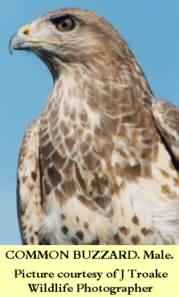
COMMON BUZZARD.
Buteo buteo
IDENTIFICATION. A heavily built bird with a small head and broad tail and wings. Plumage varies from light to dark brown, normally with a white bar across the lower chest. The brown is interspersed with cream and occasionally peach feathering. The legs and feet are yellow and small, and the eyes are generally brown.
Often mistaken for Golden Eagle, although the Common Buzzard is much smaller, and the migratory Rough-legged Buzzard.
IN FLIGHT. Commonly seen circling on rising thermals of hot air, often in groups of two or more. The broad wings, with 'finger like' feathering at the tips, and short rounded tail are spread out to catch as much uplift as possible. This allows the buzzard to stay in the air for long periods of time whilst using the minimum of energy. While soaring the wings are held in a shallow V. If the buzzard needs to get some where quickly the tail becomes narrow and the wings are flexed giving them a pointed appearance. The buzzard then glides across the sky, interspersing the glide with three determined flaps. Buzzards seem to have a lazy approach to flying, but stoops, talon binding and hovering can often be witnessed.
DISTRIBUTION. Common in both the west and north of the country, although their territory is increasing.
WHEN SEEN. All year round.
FOOD. Mainly mammals up to rabbit size and carrion (especially road kill). Large gatherings of buzzards can often be seen on a freshly ploughed fields, feeding on earthworms. Prey can be taken by stooping from great heights or by still hunting from trees or telegraph poles.
BREEDING. April - May. 2 or 3 eggs laid in a large stick nest in trees or occasionally on cliffs. Abandoned crows nests may also be used. Young hatch after 5 weeks, flying 45-50 days later.
SIZE. 51-56cm (20-22ins)
WEIGHT. 650g-1025g (1lb 7oz -2lb 4oz)
CALL. peeiou, khaa
FALCONRY.
The Common Buzzard, compared to the Kestrel, may be a better proposition as a beginners bird. Its larger size (1lb 7oz for a male, 2lb 4oz for a female) makes it hardier to any weight control mistakes that a beginner may make. Unlike some birds of prey bad habits picked up during early training can be corrected before becoming a permanent feature of the bird. The temperament of a buzzard is generally good, but beware of those small feet. If weight control is not administered correctly buzzards can become 'Footy'. The surprising reach of their legs has taken many an unwary, food holding, falconer by painful surprise!
Being a lazy hunter the buzzard is perhaps better suited to those who just want to enjoy flying a bird of prey. However some falconers believe that they are a good staring point before moving onto a Goshawk. If worked with dedication rat, moorhen and even rabbit are possible quarry.
I am quite fond of my old buzzard, Ferris. When I started to fly a Harris Hawk I made sure that I had the time and space to keep and fly this long living bird.
NB. If you buy one of these raptors it should be fitted with a closed leg ring and have an Article 10 form with it (any queries check with DEFRA).
Falconry marks
![]()
![]()
![]()